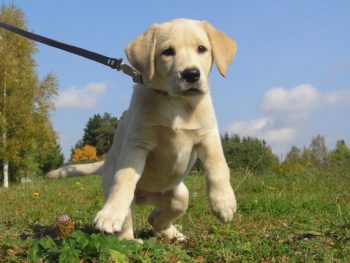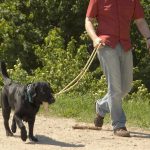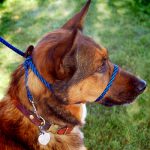
Why dogs pull on leash chocking themselves as they walk can be a real mystery at times. How can it possibly feel good. You need to train your dog not to pull on leash, or you could end up like me.
Have you been dragged down the road wrapping around trees or signs struggling to keep up to your dog. I know I have several times in the last few years.
Then you meet up with another dog walker and you are envious just watching them. Their dog is walking alongside their master with a loose leash. Don’t you wish that could be you?
This topic is very personal to me. Ten years ago, I got two male Golden Retriever liter mate puppies. That is when the tugging and pulling began. I have been dragged across roads, pulled into ditches and have come home with holes in my jeans from being pulled down.
Clearly there was many things that I did wrong with my training, but when the two were together, it seemed that they were untrainable. I just couldn’t stop my dog pulling when walking. I have learned a lot since then, and I would like to share that with you so you don’t go through what I did.
Table of Contents
Understanding Why Dog Pulls When Walking
Dogs love to be outside and a walk is a stimulating and exciting part of their day, so their desire to push ahead is very strong. We as humans don’t make ideal walking partners since a dog’s natural and comfortable walking pace is much faster than ours. Having to walk calmly by a person’s side when all they want to do is run and investigate the area requires impulse control.
Whenever you let your dog drag you to another dog or an interesting pee spot, you have built a little more staying power into their attempts to pull.
Dogs reflexively oppose restraint, so when the leash tightens and the collar presses against the dog’s neck, their natural tendency is to pull harder.
Leash pulling is often successful for the dog because the person inadvertently reinforces the pulling by allowing their dog to get to where they want to go when he pulls.
How To Stop A Dog From Pulling On A Walk
A simple way to help your dog learn how to walk with a leash without pulling is to immediately stop walking when they pull and stand  completely still until the leash relaxes, either from your dog taking a step back or turning around to give you focus. When the leash is relaxed, continue on your walk. The rest is training, training, training and repeat.
completely still until the leash relaxes, either from your dog taking a step back or turning around to give you focus. When the leash is relaxed, continue on your walk. The rest is training, training, training and repeat.
Step 1
- Take your dog outside to a place that is familiar to them, like your backyard. This is a place they won’t be as easily distracted by something new. Attach your dog to a rope that is 10-20 feet long (not retractable). Have plenty of tiny treats along to use as a reward.
- Keep you dog on the side where you have the treats and reward him right by your side when he walks with you.
- Walk quickly around your yard in all directions. When your dog happens to walk beside you, reward him with praise and a treat. Continue rewarding him all the while he continues to walk next to you.
- If he appears not to be interested, take him back inside and try again the next day.
- Practice until your dog stays by your side more often than not.
Step 2 – Once they have an understanding of Step 1, move on to more challenging training
- Still using the long leash, start walking around your yard. If he isn’t following, slap your thigh and say “lets go” to get his attention.
- When he catches up with you, reward him with treats and plenty of praise.
- If the leash gets tight and he doesn’t come, stop walking and apply gentle pressure on the leash. Leash pressure is to remind him you are there and to make it slightly unpleasant for him to ignore you. Do not force him to you. Release the pressure and praise him when he starts walking towards you. When he catches up, give him some treats and keep rewarding while he stays with you.
- Continue practicing this step until most of the time he stays by your side and comes back when you say “lets go”.
- As you are seeing good results with this training, shorten his leash to a 6-foot leash.

You can also try “The Follow” game with them. While they are on a leash, take several steps backwards from your dog. The backward movement is inviting, so your dog will likely follow you. Immediately reward them with a treat. Repeat this pattern 8-12 times until your dog is actively pursuing you when you move away.
As your dog learns that walking next to you is a pleasant, rewarding experience, he will spend less time pulling and more time walking nicely beside you.
Collars and Harnesses That Help
A head collar or front attached harness can help to discourage your dog from pulling, but you will still have to train him to learn to walk beside you without pulling. With both of these types of collars they should only be used with leashes that are a maximum of 6 feet. If your leash is too long, it is possible that your dog could get going fast enough to hurt them self if he were to hit the end of the leash too quickly.
Head Collar (Gentle Leader) – Gentle Leader does not choke your dog. It has been scientifically designed to direct the dog’s entire  body by controlling its head and nose. Wherever its nose goes, its body will follow. Talking with a trainer how to properly use is best, but at the very least, watch the video that comes along with the head collar.
body by controlling its head and nose. Wherever its nose goes, its body will follow. Talking with a trainer how to properly use is best, but at the very least, watch the video that comes along with the head collar.
Chest-led Harness – These are a perfect training aid. It takes pressure off a dog’s sensitive neck by distributing the pressure more evenly around the body. When the leash is attached to a ring located on the chest strap and your dog pulls, the harness will turn his body around rather than allowing him to go forward. Harnesses are not comfortable for all day wear, and dogs with long hair might get their fur caught up in a harness, so when not walking your dog, remove the harness from them.
Click picture to order from Amazon now.
Collars Not To Use
- Choke Chain Collars
- Prong or Pinch Collars
Both of these collars are very painful and can actually damage your dog’s trachea. They also don’t work for a dog that is going to want to pull you along, I can assure you from previous experience. Your dog can be coughing and choking from these collars and still just keep dragging you along all the while they are causing damage to their trachea. This damage could eventually lead to your dog getting laryngeal paralysis. I believe one of my dogs pulling so much on his leash caused my dog to get laryngeal paralysis.
It All Comes Back To Training
Our behavior on how we handle a dog pulling on their leash can contribute to why dogs pull on leash. Every time we let them get away with pulling on the walk, we reinforce that behavior. You will have to train your dog not to pull on leash if you want to walk comfortably with them.
If you want your dog to walk on a loose leash, you must teach him that this is what you want from him. It won’t come naturally or by crossing your fingers. It will take hard work by both of you.
You also should remember, though the walk is much more pleasant for you when your dog is walking with you with a loose leash, this is not the same thing as healing. Healing is a much more strict training, and it isn’t appropriate for an afternoon stroll. It won’t make it much fun for either of you and defeats the purpose if your dog isn’t allowed to sniff and enjoy themselves. We want our dogs to enjoy their walks, just not at the extent that we are dragging behind our dog on our belly.
This is a great DVD to help with walking nicely on leash, come when called, stop jumping on people and much more. Check it out, and make your life easier.
Please leave any questions or comments below. Share your experiences of your pulling dog. I would love you hear what you have to say. You can follow justforyourdog.com on Pinterest, FaceBook or Twitter for all the latest dog updates.
Some of the links within this post are affiliate links of which I might receive a small compensation from sales of certain items.

I really never thought about the pulling of the leash. It was something i always just accepted dogs do. It is good that this gave some insight. Keep up the good work and ill definitely be back to find more information on how to train dogs.
Reply
Chris, thanks for reading and for your comment. I hope you do stop back for more information. I have accepted the pulling also, but I am working on changing that behavior while still making sure my dog is happy and enjoying his time outside.
Reply
Very insightful! I have two large boxers myself and they are some of the most playful (and strongest) pets I’ve ever had. Over the past few years I sort of accepted their perpetual wild behavior when outdoors, but I will definitely put your advice to the test. I appreciate you encouraging us owners to treat our pups to more treats and more walks, how awesome!! Thank for your post and for looking out for the doggos.
Reply
Andrew, thanks for your comment. I have been pulled around and completely give into making sure my dog is happy,so maybe with my next dog I will achieve what I am talking about. At this point I haven’t either.
Reply
We had a dog that was constantly pulling and I know it came down to us for not taking the time to train him. I like your suggestion to stop and wait until your dog realizes that you are waiting for him to stop pulling before you start walking again.
Some great suggestions as we are thinking of finding a new family friend and want to be sure we train him right from the start.
Reply
Thanks for the comments Paul. I also screwed up training my last 2 dogs, that is why I am so familiar with this subject. Between being busy with life and the amount of time required to get that well-trained dog can be hard, but maybe just doing a few of the tips can help you get your dog to an acceptable place. Good luck when you get a new one.
Reply
My dogs always want to pull so I found your article interesting. One of the things I do before actually starting on the walk is to play fetch three or four times. This tames the exuberance a little bit. Your graphics are nice and the text easy to read. Nice use of headings. All in all I give you high marks for such a nice site.
Reply
Thanks for reading and the comments. I like the idea of doing a little fetch ahead of time to use up some of that energy.
Reply
Like I said in the article, I have been putting up with it for years, my fault also. My next dog I’m hoping to do a better job. Good luck with yours. I hope of them will work. Mine has gotten too old to bother. Thanks for your comments.
Reply
Do you know anything about boundary training? I don’t have a fence and it’s a big concern for me.
Reply
I do know a bit about boundary training. If this is the route you are going to take, plan on investing a lot of time. Probably 10 weeks, but it will be well worth it if you can put in the time. You will want to pick up small flags, and start the training in your house. Have your dog touch the flag, bring them away from flag and reward them when they are away from the flag. Move it outside after that Place flags 8-10′ apart around the border you are using. Put your dog on a leash around 20′ long and walk around. When your dog goes near the flag, bring the back to you and reward them. The trick is to train them that moving away from the flag is rewarding. Please let me know how your training goes whichever route you choose. It helps other know what works best.
Reply